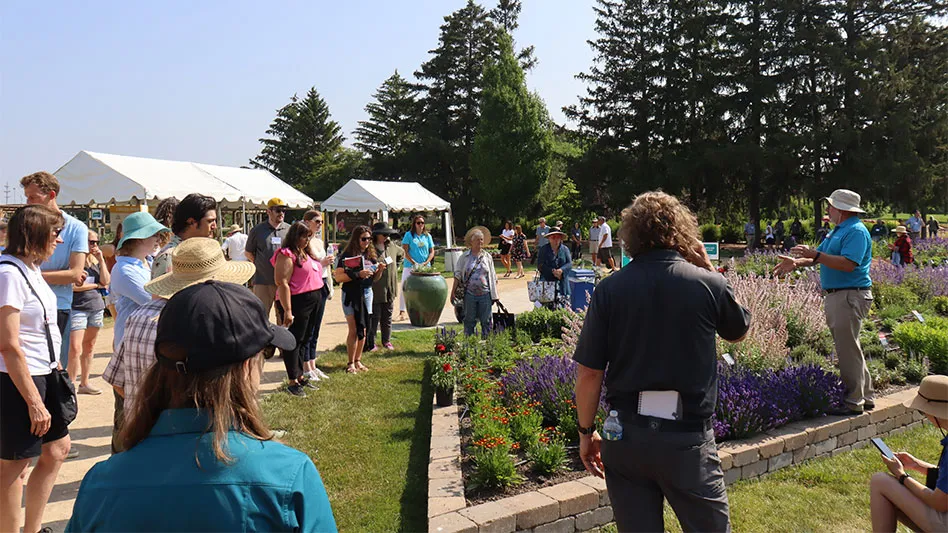
Dr. James Gibson has a lot of horticultural knowledge under his belt, including a bachelor’s degree in plant and soil science from West Virginia University in Morgantown, followed by a master’s and doctoral degree from North Carolina State University. Currently, he serves as the technical lead for Syngenta Flowers and shared tips on producing quality dipladenia and mandevilla in his Cultivate’20 Virtual session.
Mandevilla vs Dipladenia
According to Gibson, dipladenia are bred for more round, controlled habitats, and are more shrub-like than vine-like. Its colors also range from red, pink and white. The traditional mandevilla, however, is more of a vining crop and requires trellising. Colors range from white, pink, red and yellow.
Since mandevilla are traditionally grown in southern regions and are shipped to retail garden centers, Gibson decided to focus on the production of dipladenia.
“From a grower’s perspective, the dipladenia are very popular because they are programmable as long as certain parameters and protocols are focused,” Gibson said. “While it is susceptible to some pests and diseases, it actually has minimal pest issues, as well as an outstanding shelf life, which result in retail sell-through.”
From a consumer’s standpoint, dipladenia is common because of its tropical, valuable and durable nature, Gibson said. “For less than $20, a homeowner can purchase 3- to 4-quart plants, place them in a deck planter and experience flowering all season long with minimal maintenance.”
Parameters for success
“Focusing on some of the key parameters will guarantee success,” Gibson said. The first thing growers have to do is provide pest-free and properly fertilized stock plants that generate high yielding cuttings that perform in propagation — a propagation environment that has warm temperatures and proper misting.
According to Gibson, pinching and shearing is important in order to shape the plant, and environmental conditions, such as light, temperature and photoperiod are essential. Nutrition is also key for keeping tone, as well as proper rooting and development. Growth regulation is good to avoid stretching and post-harvest treatments are advised because they enhance retail shelf life by improving flower retention and lower leaf drop.
Dipladenia propagation
According to Gibson, there are specific guidelines for propagation:
- Cuttings should be stored in a cool temperature above 48° F to avoid blackening and tip burn
- The rooting time is about five to six weeks
- Bottom heat temperature is critical and 70-74° F ambient air temperature improves the propagation phase
- Misting duration is critical because it will achieve uniformity in the propagation tray
- Pinching is done at the end of the propagation, which results in more rounded plants and reduced vining
- PGRS can also be used to improve tone and reduce internode stretch
Dipladenia propagation stresses
Some other important aspects of propagation, Gibson said, are shipping processes and stressors such as the lack of misting for root formation and fungicide use that helps prevent foliar diseases. With shipping, Gibson said warm storage and delayed routes result in breakdown, and long-term storage (24 hours or more) of dipladenias in an overly cool climate can result in cold damage.
Dipladenia Finishing
During late propagation, terminal flower buds may occur, but can be easily pinched out during the process. Gibson also said that while PGRS can be used, they are generally not needed. However, if their use is absolutely necessary, they can result in a delayed flowering. It’s also important to have the adequate amount of heating and lighting intensity for optimum quality, and the proper irrigation amount since over-watering or under-watering can lead to bottom leaf yellowing on young plants.
Pest management and fungal diseases
Although Gibson said dipladenia “is not a very challenging crop when it comes to insects and diseases,” they are still susceptible to some.
According to him, aphids can occur “fairly quickly” on the upper growth areas. If grown dry, spider mites can also occur, and thrips and mealybugs can cause deformity. Diseases such as leaf spots, botrytis blight, fusarium oxysporum, powdery mildew and phytophthora nicotianae can also appear, with leaf spots being the most common if the conditions are a little too wet.
The takeaway
The production process for dipladenia is about 20-22 weeks, Gibson said. “You’ve got six to seven weeks in propagation, roughly 13 to 15 to weeks in production, which all depends on the container size.”
As for color combinations upon the conclusion of the production period, Gibson suggested pairing dipladenia with slow growing bold foliage that competes well with dipladenia’s vigor. “You don’t want anything that’s too aggressive or anything that will overpower dipladenia,” he said. “Let the dipladenia show itself off.”
Latest from Nursery Management
- GardenComm 2024 Annual Conference registration is open
- Landmark Plastic celebrates 40 years
- CropLife applauds introduction of Miscellaneous Tariff Bill
- Greenhouse 101 starts June 3
- Proven Winners introduces more than 100 new varieties for 2025
- Rock Star Roses
- The container challenge
- Find sustainable solutions





